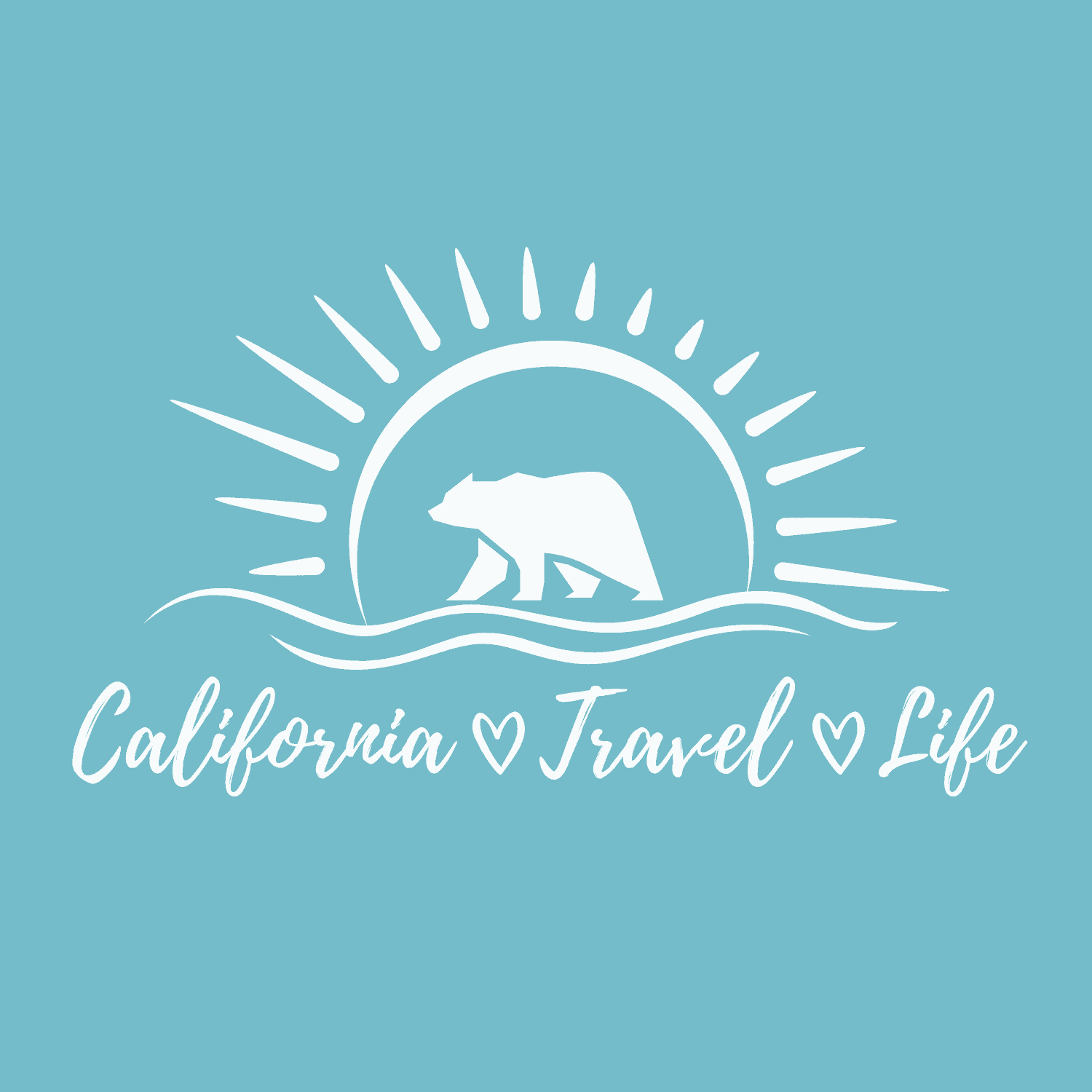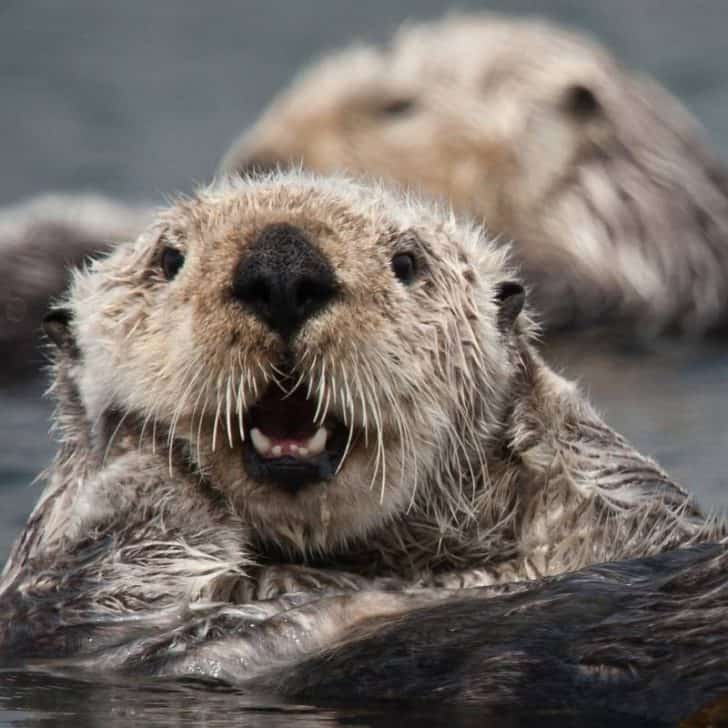There are several cute and charming animals that call California home, but you are hard pressed to find one as adorable as a sea otter. Seeing a sea otter in the wild is always a treat, but where exactly can you see California sea otters?
I have been obsessed with California sea otters since I wrote a research paper on these curious creatures way back in 7th grade Life Science class. Over the years, I have traveled up and down the coast, eager to catch a glimpse of these precious, endangered animals in the wild. And thanks to extensive research and firthand experience, I know the best places to view sea otters in California.
Before I list my favorite places for spotting sea otters in Caifornia, I want to share some fun facts about these interesting creatures.
California Sea Otters- Where to Spot Them & Lots of Fun Sea Otter Facts
How Many Sea Otters Live in California?
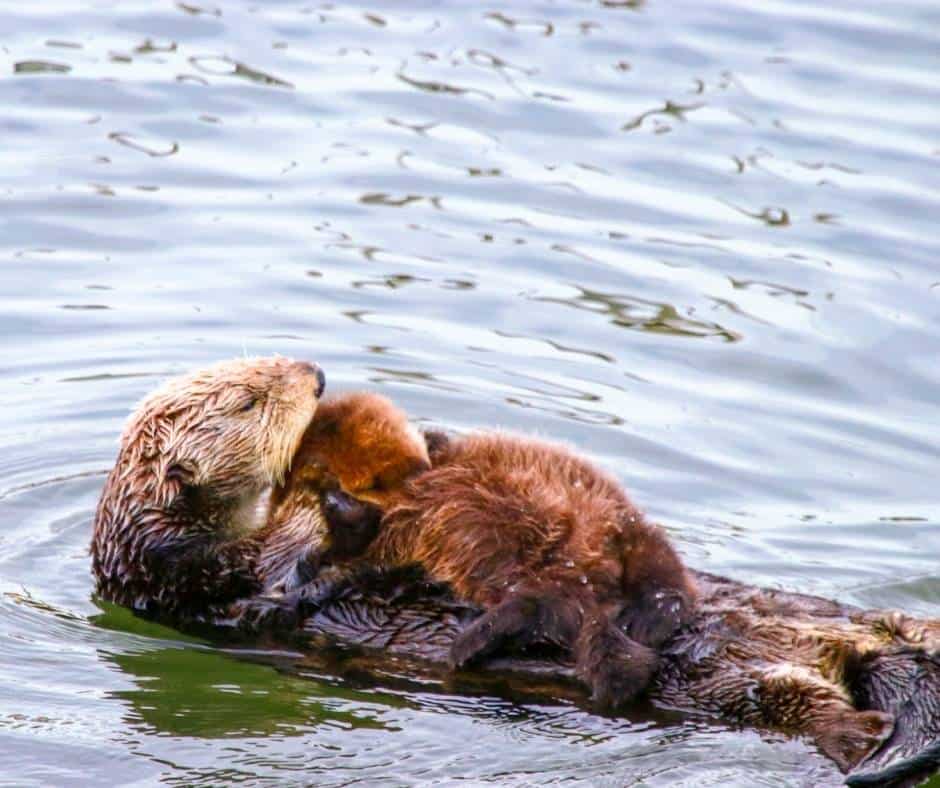
Historically, the range of the sea otter extended up and down the California coast. Unfortunately, these dense-coated marine mammals were almost wiped out completely by fur traders by the early 19th century. By 1910, there were only about 50 sea otters left in California!
Thankfully, sea otters were given protected under the Endangered Species Act in 1977, and their population has slowly been recovering ever since. Before they were protected, there were only about 1,000 sea otters off the coast of California.
After a few decades of steady increase, the population has seen a bit of a decline. This is likely due to shark attacks, algae blooms, and disease. Today, there are a little over 3,000 sea otters in the wild and the good news is that range is continuing to expand.
Where do you Sea Otters Live in California?

The furthest south you will find sea otters is by San Nicholas Island (of Island of the Blue Dolphins fame), the most remote of all the Channel Islands, located 61 miles off the coast.
It is home to a large population of otters, many which are descendants of Southern California sea otters which were relocated there once sea otters were banned from the region in 1986 thanks to pressure from the commercial fishing industry.
You read that right. A protected species was banned from its native territory because the commerical fishing industry didn’t want to compete with the sea otters.
Unfortunately, we can’t visit the sea otters of San Nicholas Island because the island is controlled by the US Navy. Fortunately, there are plenty of other places where you can see sea otters in California!
Read about the efforts to return sea otters to portions of their former range in Northern California and Oregon.
Why are California Sea Otters Important?

Sea otters are a keystone species. This means that they are a species that the ecosystem, in this case the kelp forest, is highly dependent on in order to maintain balance. When there are no sea otters in the kelp forest, the entire ecosystem suffers.
Sea urchins graze on kelp. Without sea otters around to eat sea urchins, the kelp forests can be over grazed, causing the entire ecosystem to become unhealthy. Kelp forests flourish when there are sea otters living in them to keep the system in balance.
Healthy kelp forests are obviously important to the animals that live in this ecosystem, but they are also important to humans as well. Kelp forests are nurseries for several species of fish that are fished commercially. They also provide a platform for ecotourism, which can help boost the local tourism economy.
Sea kelp is also becoming more and more popular as a product unto its own. There are kelp fertilizers which are great for growing bigger and better backyard vegetables, kelp dietary supplements filled with antioxidants, and edible seaweeds that are especially popular in salad form.
What do California Sea Otters Eat?

The California sea otter’s favorite food is sea urchin. The more sea urchins in an area, the more likely young sea otters survive into adulthood.
In addition to sea urchin, sea otters will also eat abalone, mussels, clams, snails, and crabs. In other words, they tend to stick to a diet of invertebrates. They will use tools, like a rock, to help crack open shells.
Fun fact: Sea otters eat 25% of their body weight every day!
What is a Group of Sea Otters Called?
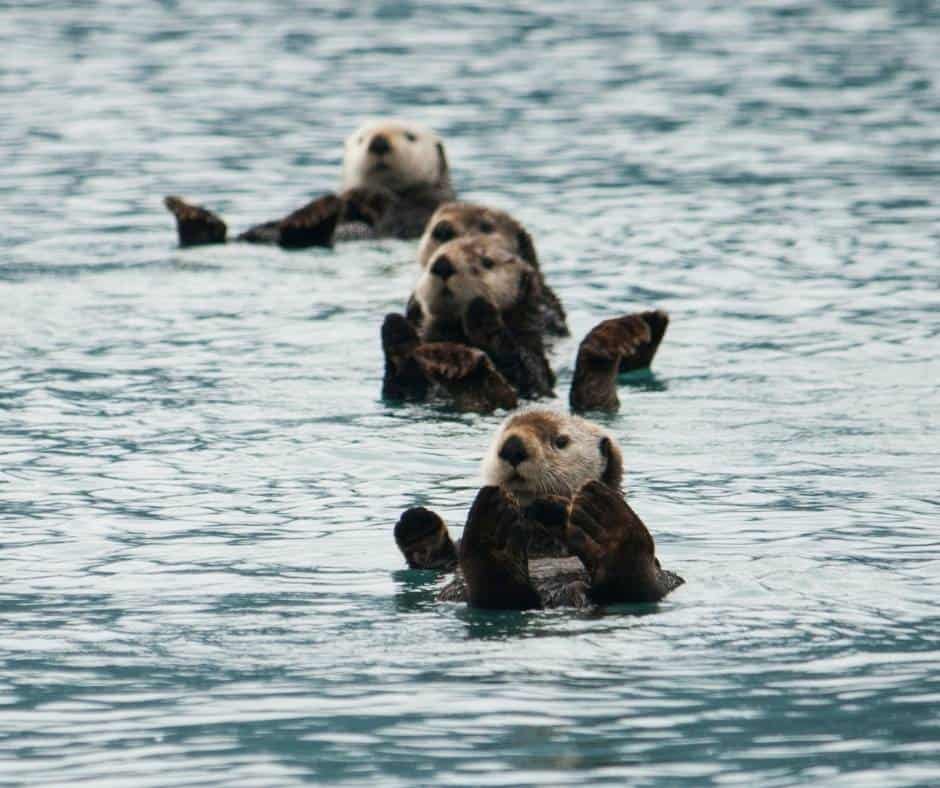
A group of sea otters is called a raft. How cute is that? The name “raft” probably comes from the fact that sea otters will wrap themselves in seaweed to keep from floating away from each other and a big group of them floating together does kind of look like a raft!
What is the Difference Between a River Otter and a Sea Otter?

There are over a dozen different otter species in the world, but only two in North America- the sea otter and the North American river otter. The most obvious difference between them is that one lives in the ocean and the other lives in fresh water, but there are a few other things that make each species distinct.
Sea otters are much bigger than river otters. They weigh anywhere from 45-90lbs while little river otters only weigh about 20 lbs. Sea otters have a short, flat tail and river otters have one that is long and round. Sea otter fur is much more dense, giving them that super furry face that everyone loves. River otters look more like weasels.
Fun fact: Sea otters have the densest fur of any animal. This dense fur is what keeps them warm since they don’t have a thick layer of blubber like walruses, seals, and sea lions.
River otters swim on their stomachs while sea otters spend most of their time floating on their backs. River otters spend a good chunk of their lives on land as they mostly use water to travel and hunt. Sea otters, on the other hand, spend their lives almost exclusively in the water; they even give birth in the ocean! They also tend to only have one pup at a time while river otters often have four!
Love California wildlife? Check out our guide to the hawks of Southern California.
What are the Best Places to See Sea Otters in California?
Elkhorn Slough in Moss Landing
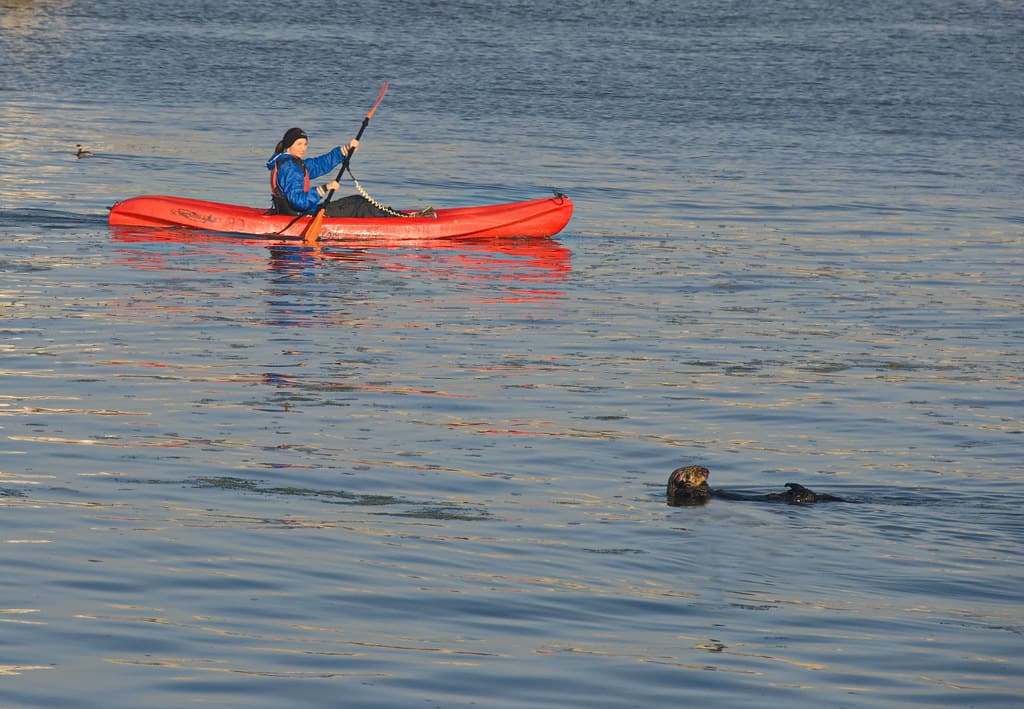
My absolute favorite place for viewing sea otters in California is at the Elkhorn Slough about 20 miles north of Monterey. This special place is home to the largest concentration of sea otters on the California coast, with over 100 sea otters calling the estuary home.
Elkhorn Slough is one of the best places for wildlife viewing in the state. In addition to sea otters, it is home to sea lions, harbor seals, over one hundred bird species, and dozens of fish species. It is no surprise that it has been designated a Wetland of International Importance.
The best way to view sea otters in Elkhorn Slough is in a kayak. Sea otter sightings are pretty much guaranteed.
There are individual kayak rentals available but if you are a first timer, I highly recommend a guided kayak tour. Guides know exactly where to go to see the wildlife and will provide you with a wealth of information about these critters.
The very best time to kayak in Elkhorn Slough is during the spring when there are baby sea otters, harbor seals, and sea lions to tug at your heart strings. They are even more cute in person than you can imagine!
Morning is the best time to paddle the tidal waters of the Elkhorn Slough. Winds are more likely to pick up in the afternoon.
If you aren’t up for kayaking, check out the harbor in Moss Landing. You will often view sea otters floating around just offshore. There is also a group of sea otters that likes to hang out in the cove near the sand dunes at Moss Landing State Beach.
Tip: if you get hungry after all that paddling and sea otter viewing, we recommend you stop by the Haute Enchilada Café, Gallery & Social Club in Moss Landing for lunch. This eclectic cafe serves up Latin American dishes, many of which feature sustainable seafood and local organic produce, and has a gallery featuring local artists.
Monterey
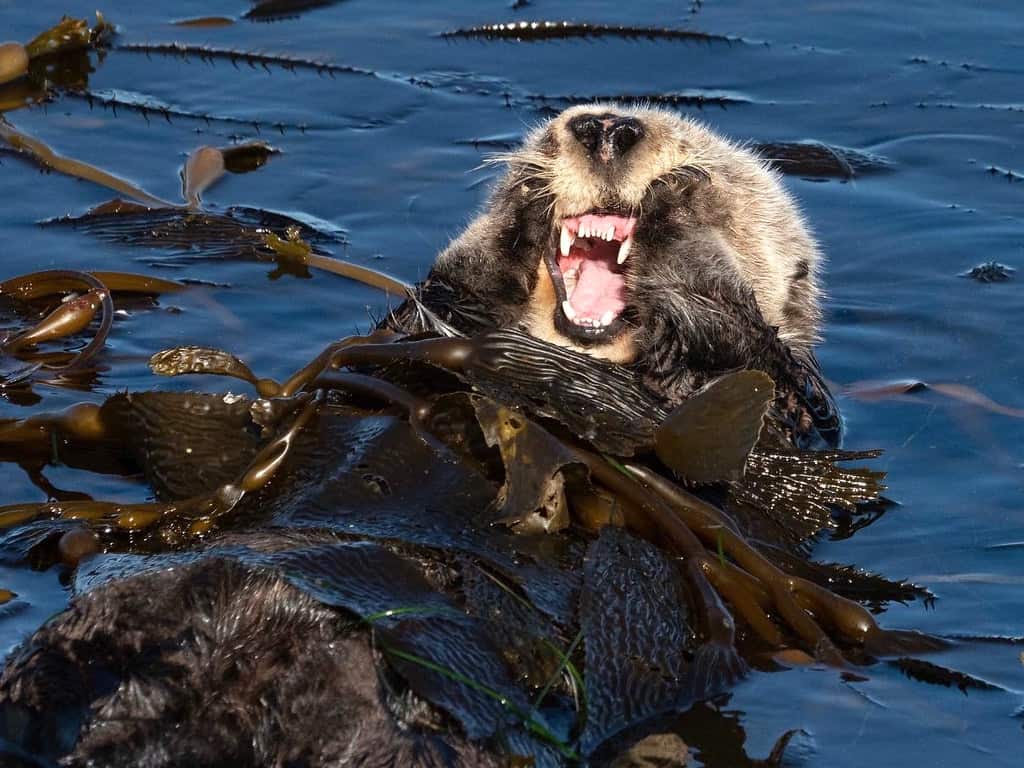
Monterey is a popular seaside vacation destination, known for being the home of the famed Monterey Bay Aqaurium, one of the finest aquariums in the world. While you can see sea otters at the Aquarium, it is more exciting to see them in the wild.
The Monterey Bay Coastal Recreation Trail runs from Lovers Point Park, past Cannery Row (where the aquarium is located) and Fisherman’s Wharf, and continues 18 miles towards Castroville. It is a great trail to bike, stopping along the way to check for sea otters bobbing out in the water.
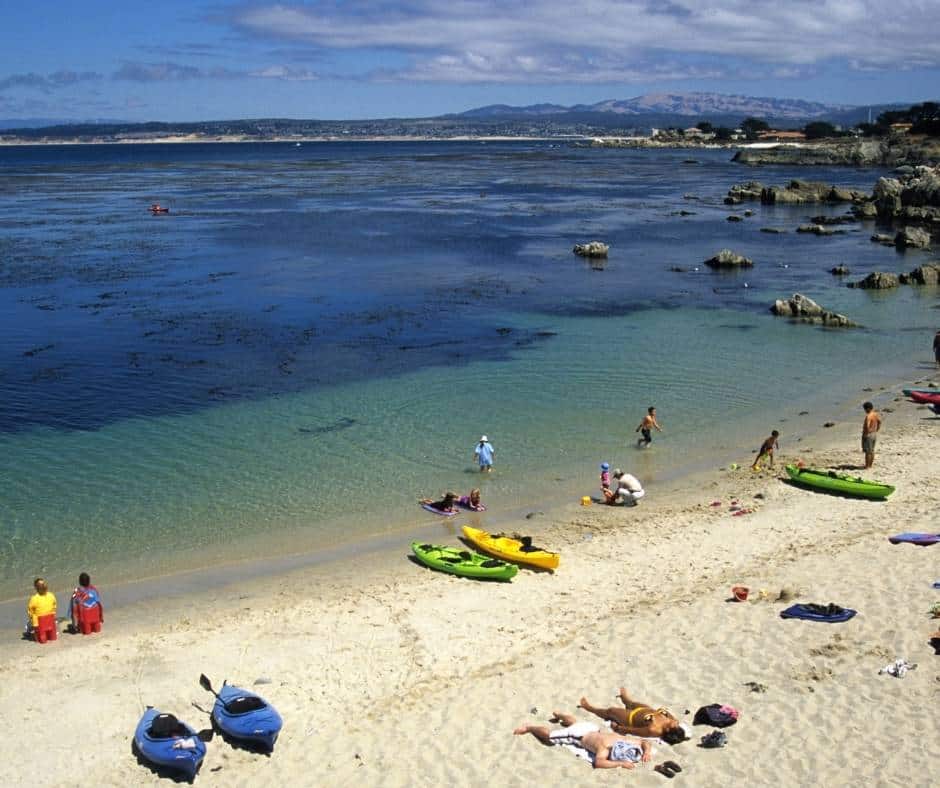
Lovers Point Park and Beach is technically in neighboring Pacific Grove, but it is close to all the action in Monterey and also happens to be a great place for spotting sea otters. There is a nice kelp forest offshore where they like to hang. You can rent kayaks and explore the area, scuba dive, or just watch from the picture-perfect shoreline.
I have seen sea otters swimming around just below Old Fisherman’s Wharf many times. Grab a bowl of the famous clam chowder in a sourdough bread bowl and enjoy it while keeping your eyes on the water around the wharf.
There are several whale watching trips that originate in Monterey, and are especially popular in the winter during gray whale season. Sea otters are commonly spotted on these trips as well.
Pebble Beach
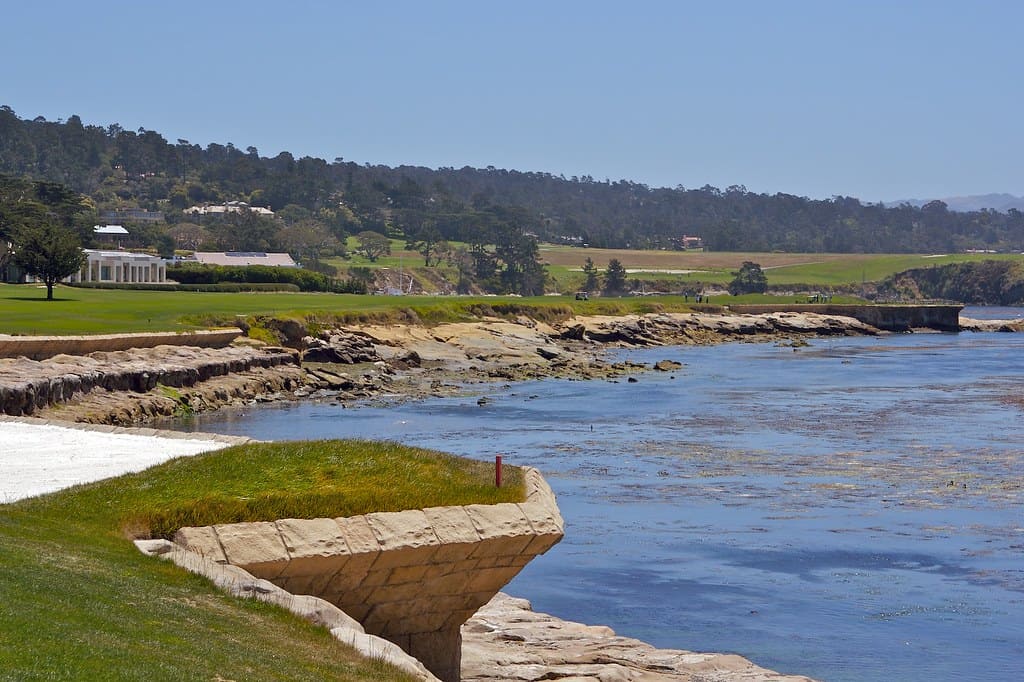
Well known as one of the premier golfing destinations on the planet, Pebble Beach is also a haven for wildlife. Harbor seals, sea lions, deer, migrating whales, birds, and even the mighty sea otter call this beautiful place home.
While you can spot sea otters bobbing around in the water from the golf course, you don’t have to be a golfer to enjoy the resident sea otter population. Stillwater Cove‘s calm and protected waters are the place to be.
You do have to pay the fee to access 17-Mile Drive (which is well-known for its incredible views) and head to the public parking along Cypress Drive which is right next to the Beach & Tennis Club. You can head to the beach by following the public access path or join a guided kayaking or stand-up paddleboard tour of the cove.
Point Lobos State Reserve
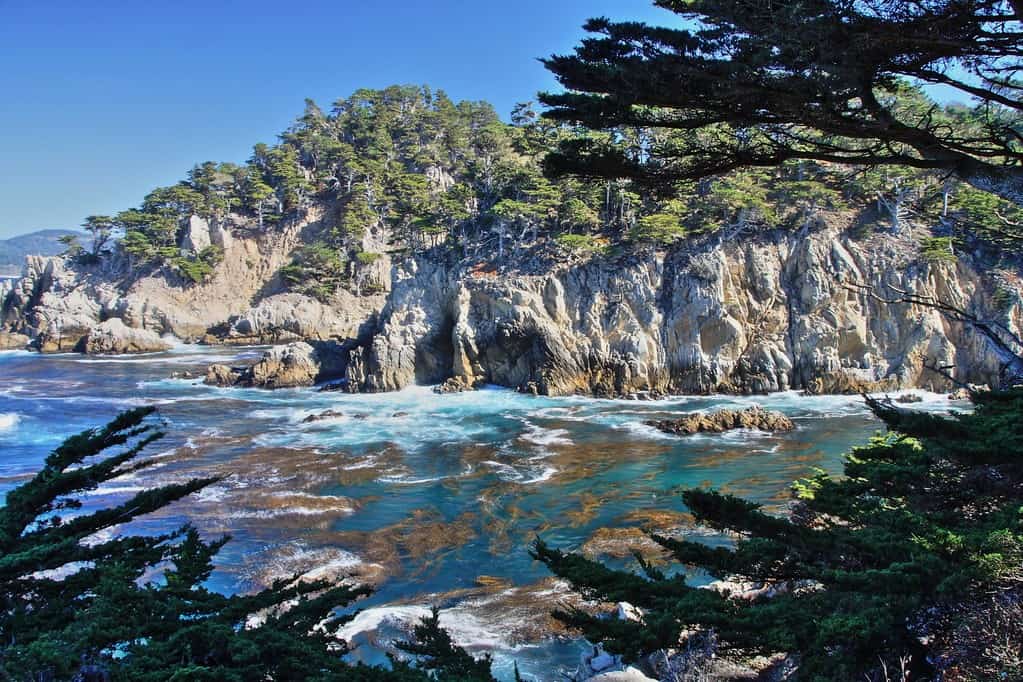
Located just south of Carmel-by-the-Sea, Point Lobos State Reserve was once deemed “the greatest meeting of land and water in the world”, by Australian landscape artist Francis McComas.
It is a striking landscape of turquoise waters, craggy cliffs, and sculptural Monterey cypress trees. One of the “crown jewels” of the California State Park system, Point Lobos is a great place to enjoy hiking and wildlife viewing while surrounded by some of the most stunning scenery anywhere.
The best time to view sea otters in the coves of Point Lobos is during the fall and early winter. China Cove and Hidden Beach are two of the best places to spot them. Spring is another great time if you are trying to catch a glimpse of babies. Binoculars will certainly help your efforts as well.
If you are a scuba diver and can score one of the 15 permits offered per day, Whalers Cove and Bluefish Cove are the best places to explore the kelp forests that the otters call home.
Morro Bay

Morro Bay, a small coastal town known for towering Morro Rock that looms over the bay, has become a great destination for viewing sea otters in recent years.
This population of around 40-60 sea otters is doing very well, thanks in part to the Morro Bay Estuary which provides protection from predators and a safe place to raise little sea otter pups.
Morro Rock is a great place to visit and watch the sea otters in the kelp beds, especially in the morning. Look for them on the trail that leads from the parking lot on the bay side of the rock. Binoculars are useful for spotting the otters.
There are several spots along the Morro Bay Embarcadero that you can stop and catch views of the sea otters floating in the bay. You will often see them from the pier.

The best way to get up close and personal with the sea otters is by taking a kayak tour. Operators like Central Coast Outdoors know exactly where these furry critters like to hang out, and will give you lots of great information along the way. Some tours even involve a sunset paddle with wine!
If you would rather paddle on your own, there are several kayak outfitters in the area. Just remember to respect the wildlife and give them space.
If you want to get out on the water but aren’t up for paddling, you can rent a pontoon boat from Estero Adventures and cruise around the bay in search of otters. Prefer to leave the driving to someone else? Take a tiki cruise, head out on a cruise with Captain Stew, or even on a sea sub tour which will explore life above and below the water line.
In nearby Cayucos, head to Estero Bluffs State Park and take the three-mile trail that hugs the coastline. Bring your bincoluars and keep your eyes out for sea otters bobbing offshore.
San Simeon

San Simeon is a great place to visit if you want to see sea otters and elephant seals in the same place. San Simeon’s elephant seal rookery is definitely worthy of your time, and the parking lot is a great jumping off point for your sea otter spotting adventure.
Take the Boucher Trail north along the beach towards the Piedras Blancas Light Station, and keep your binoculars handy. You will usually spot sea otters along the water adjacent to the two-mile trail. They are commonly seen near the lighthouse.
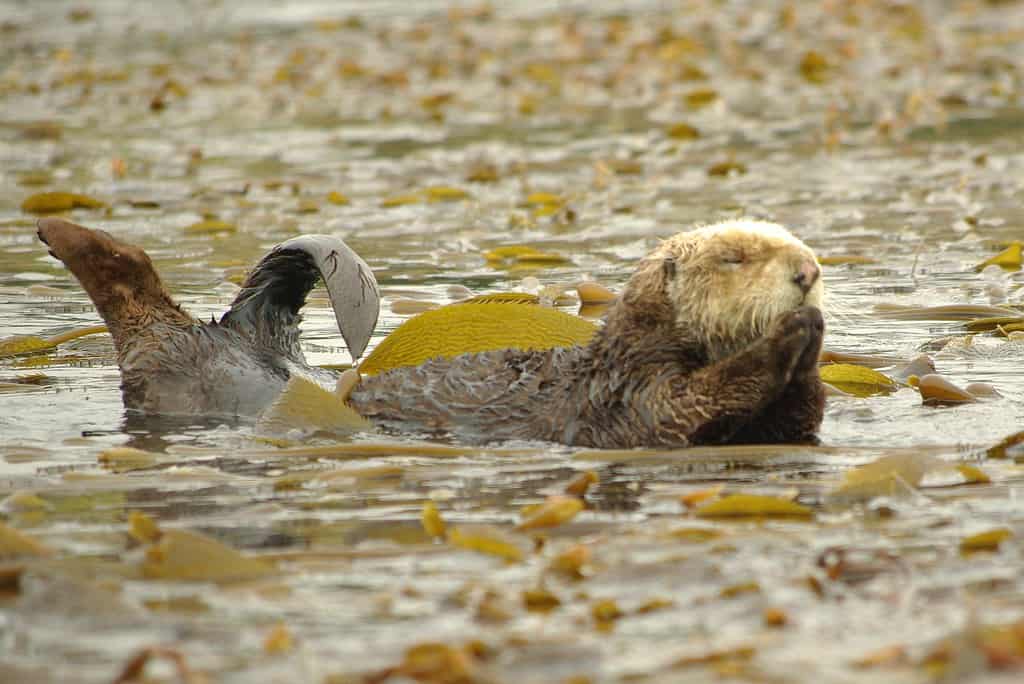
Closer to town, you can also see sea otters in San Simeon Cove, home to the San Simeon Pier and William Randolph Hearst Memorial State Beach. Make a reservation for a tasting at the Hearst Ranch Winery tasting room which sits by San Simeon Cove, to celebrate you sea otter viewing victories afterward.
Avila Beach

Avila Beach is a cute little seaside vacation destination for many Central Valley families. It has a nice beach, lots of ice cream and salt water taffy, and a pier. The water is chilly, but those escaping those Central Valley summers never seem to care!
In recent years, I have seen sea otters bobbing around in the waters just off the Avila Beach Pier. You can also see them over by the Harford Pier which is located on the north side of town along San Louis Obispo Bay. If you want to head out into the bay you can rent a kayak from Avila Beach Paddlesports.
9 More Places for Sea Otter Spotting in California
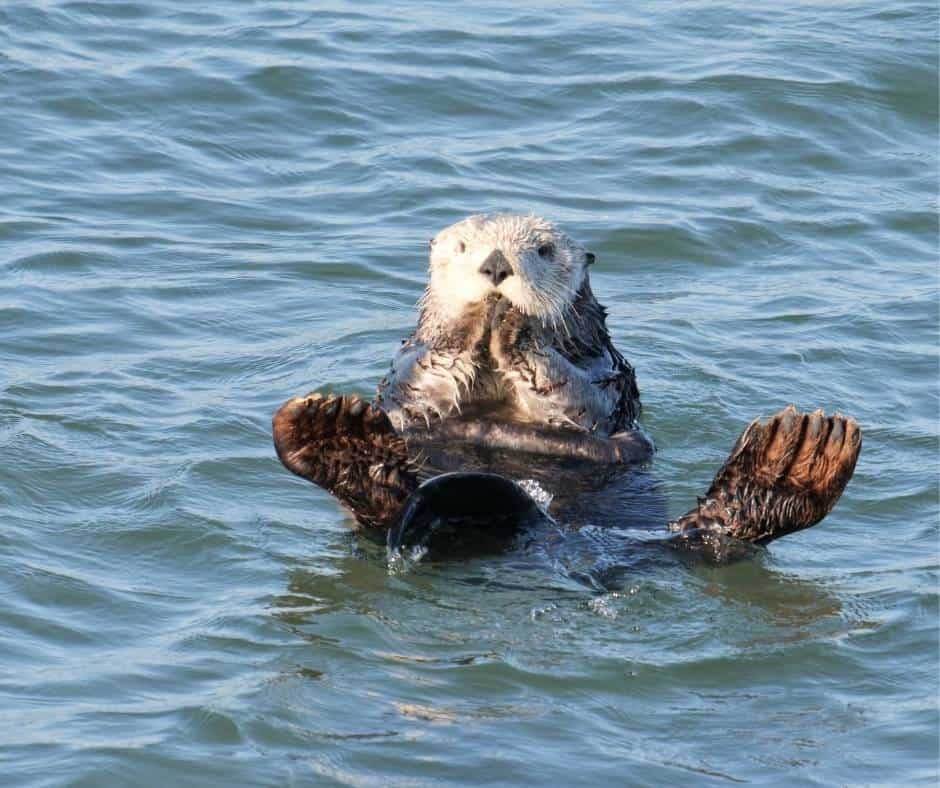
Almost the entire central California coastline has potential for sea otter spotting. Pack your binoculars and keep an eye on kelp beds, where sea otters tend to hang out. Here are a few more spots we know that have sea otter viewing opportunities:
- The Bluff Trail at Andrew Molera State Park in Big Sur.
- Partington Cove Beach in Julia Pfeiffer Burns State Park in Big Sur.
- The Castle Rock Viewpoint near the famous Bixby Creek Bridge in Big Sur.
- Garrapata State Park which has two miles of beachfront in the Monterey Bay Marine Sanctuary.
- Pismo Beach near the pier. Sea otters were considered a pest here for decades because of the impact they had on Pismo Beach’s once robust clamming tourism industry.
- Moonstone Beach in Cambria. You can also rent kayaks here.
- Montaña Del Oro State Park‘s Bluff Trail is a good location for sea otter spotting just south of Morro Bay.
- Wilder Ranch State Park in Santa Cruz. Check out the views from the sea cliffs along the Old Cove Landing Trail.
- Año Nuevo State Park in Pescadero is one of the northermost places to see sea otters in California. This state park is known for being a elephant seal haven in the winter months.
Ready for a vacation? Don’t miss these incredible Southern California weekend getaways.
Lead image via Flickr.
